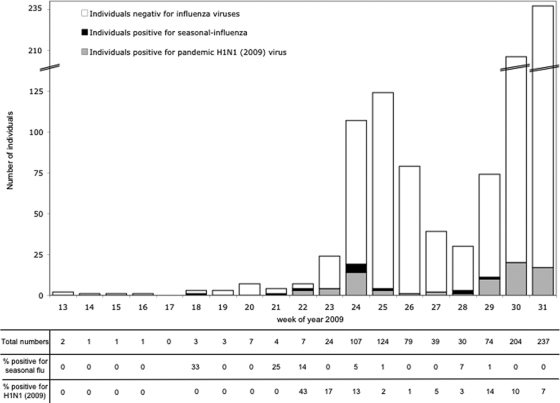The pandemic (H1N1) 2009 influenza virus emerged in Mexico and the United States at the end of March 2009 (3, 4) and caused the first influenza pandemic since 1968. Even though the course of the disease is mild in general, risk groups (like pregnant women, small children, and patients with underlying diseases) are in danger of severe complications (2). Specific nucleic acid tests were set up shortly after the genome sequence was published (6). Diagnostic tests have been used in national surveillance programs to limit virus transmission and to provide adequate therapy regimens for risk groups with respiratory symptoms. In April, we mainly tested patients arriving from Mexico or the United States. During the onset of viral transmission in Europe, one local outbreak at a school in Cologne (June) and frequent infections in people spending their vacations in Spain (July) resulted in more than 30 influenza tests per day at our Institute. The majority of people were tested due to potential exposure to pandemic (H1N1) 2009 influenza viruses rather than severe illness. The index of acute respiratory infections in Germany remained low during the whole observation period, after elevated indices due to seasonal influenza had returned to normal in week 11 of 2009 (http://influenza.rki.de/).
Nasopharyngeal swab specimens from patients were collected at hospitals and outpatient centers in and around Cologne, Germany, and were eluted in phosphate-buffered saline at the Institute of Virology. RNA extraction was done by using either MagnaPure compact from Roche (200-μl volume for RNA extraction, eluted in 50 μl) or the Versant kPCR Sample Prep System from Siemens (500-μl volume for RNA/DNA extraction, eluted in 100 μl). Seasonal influenza virus was detected with the Qiagen influenza kit for LightCycler, and the new pandemic influenza virus was detected according to TaqMan real-time PCR protocols communicated by the national German influenza reference laboratory at the Robert Koch Institute in Berlin (www.rki.de/cln_160/nn_200120/DE/Content/InfAZ/I/Influenza/IPV/Schweinegrippe_PCR.html).
Overall, 949 individuals were tested for influenza virus infections from 27 March to 2 August. The pandemic (H1N1) 2009 virus was found in samples from 75 people (7.9%), whose median age was 19 (range, 2 to 82) years. The highest detection rates in weeks 23, 24, and 29 to 31 correlated with a local outbreak at a school and the start of summer vacation, respectively (Fig. 1). Interestingly, 12 (1.3%) individuals tested positive for human influenza A/B virus but were negative by the specific pandemic (H1N1) 2009 virus PCR (Fig. 1). These patients had a median age of 40 (range, 2 to 57) years and were sporadically detected throughout the observation period. Two of these patients were diagnosed shortly after arriving from a journey to the Southern Hemisphere. At least 9 of these 12 individuals infected with seasonal influenza virus presented with typical influenza-like symptoms (fever, cough). Of note, 109 patients were also screened for a panel of respiratory viruses (1), and 4 tested positive for rhinoviruses, 1 tested positive for parainfluenza virus, and 1 tested positive for respiratory syncytial virus.
FIG. 1.
Number of patients tested for influenza virus infections at the Institute of Virology, University of Cologne.
The diagnosis of viral respiratory infections attracts more and more attention either to provide specific antiviral treatment (influenza) or to exclude bacterial infections in order to avoid antibiotic therapies (1). The analysis of a large number of people for influenza virus infections because of the pandemic (H1N1) 2009 influenza virus repeatedly revealed the presence of seasonal influenza viruses beyond the influenza season in Germany. These results are in line with previous findings reporting limited influenza epidemics during the summer (5, 7). Therefore, despite overwhelming interest in the pandemic (H1N1) 2009 influenza virus, seasonal influenza virus should not be neglected in the diagnosis of patients with influenza-like symptoms.
Footnotes
Published ahead of print on 30 September 2009.
REFERENCES
- 1.Bonzel, L., T. Tenenbaum, H. Schroten, O. Schildgen, S. Schweitzer-Krantz, and O. Adams. 2008. Frequent detection of viral coinfection in children hospitalized with acute respiratory tract infection using a real-time polymerase chain reaction. Pediatr. Infect. Dis. J. 27:589-594. [DOI] [PubMed] [Google Scholar]
- 2.Dawood, F. S., S. Jain, L. Finelli, M. W. Shaw, S. Lindstrom, R. J. Garten, L. V. Gubareva, X. Xu, C. B. Bridges, and T. M. Uyeki. 2009. Emergence of a novel swine-origin influenza A (H1N1) virus in humans. N. Engl. J. Med. 360:2605-2615. [DOI] [PubMed] [Google Scholar]
- 3.Peiris, J. S., L. L. Poon, and Y. Guan. 2009. Emergence of a novel swine-origin influenza A virus (S-OIV) H1N1 virus in humans. J. Clin. Virol. 45:169-173. [DOI] [PMC free article] [PubMed] [Google Scholar]
- 4.Smith, G. J., D. Vijaykrishna, J. Bahl, S. J. Lycett, M. Worobey, O. G. Pybus, S. K. Ma, C. L. Cheung, J. Raghwani, S. Bhatt, J. S. Peiris, Y. Guan, and A. Rambaut. 2009. Origins and evolutionary genomics of the 2009 swine-origin H1N1 influenza A epidemic. Nature 459:1122-1125. [DOI] [PubMed] [Google Scholar]
- 5.Wolf, D. G., D. Rekhtman, E. Kerem, A. Hay, N. Mador, E. Greenbaum, M. Dorozhko, V. Gregory, Y. P. Lin, and Z. Zakay-Rones. 2004. A summer outbreak of influenza A virus infection among young children. Clin. Infect. Dis. 39:595-597. [DOI] [PubMed] [Google Scholar]
- 6.World Health Organization. 2009. Viral gene sequences to assist update diagnostics for influenza A (H1N1). World Health Organization, Geneva, Switzerland. http://www.who.int/csr/disease/swineflu/swineflu_sequences_labs_20090425.pdf.
- 7.Yonezawa, Y., Y. Inoue, Y. Kitahori, and M. Nakano. 2006. An influenza AH3 outbreak in a hospital, Nara Prefecture, Japan, in summer 2005. Jpn. J. Infect. Dis. 59:62-63. [PubMed] [Google Scholar]



